Free Shipping on Orders over $75 to the Contiguous US
Free Shipping on Orders over $75 to the Contiguous US
What Lights Do I Need to Grow Microgreens?
January 13, 2025 10 min read 0 Comments
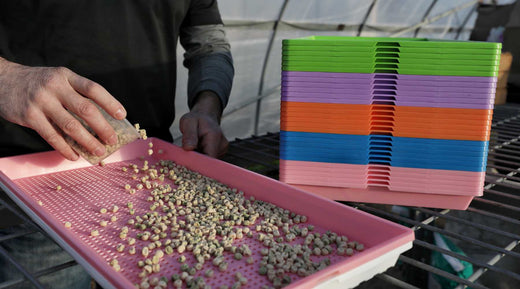
Quick Reference
Grow Light SetupTypes of Grow Lights
How far should my lights be from microgreens?
How many hours of light do microgreens need?
What do light spectrums have to do with growing microgreens?
What are the best lights for microgreens?
How many watts do microgreens need?
What's a T8 fluorescent?
When should I expose microgreens to light?
How do you know your microgreens are getting enough light?
How many hours a day should your microgreens get light?
What light intensity do you need for microgreens?
What is the best color temperature for microgreens?
Can a grow light be too strong?
Microgreen Grow Lights Setup
Microgreens are an excellent crop for anyone to grow because they are very flexible with their requirements, including lighting. Because microgreens do well using a variety of light sources, it's easy for the home grower to start where they are and still produce delicious microgreens.
To grow microgreens, you can start with a few trays by a sunny southern window or invest in a full vertical rack system with high-powered LEDs and commercial production.
There are many factors to consider when recommending the right lights for your microgreens grow setup. Are you growing for home use or commercial sales? How many trays are you growing? Do you have access to sunlight, for example, a greenhouse or sunroom? Are you planning to grow year-round? Do you need reliable harvest times, or are you more flexible? How much money can you invest in your light system?
How Much Light Do Microgreens Need?
Two factors are involved in this question: one, the quality and strength of the light source, and two, the duration of lighting. Six hours is the minimum duration of light needed to grow healthy microgreens, but more is better. The strength and quality of light will depend on your choice of lights.
Here, we will review the most popular lighting options, ranked from lowest to highest in terms of cost, and list some of the pros and cons of each.
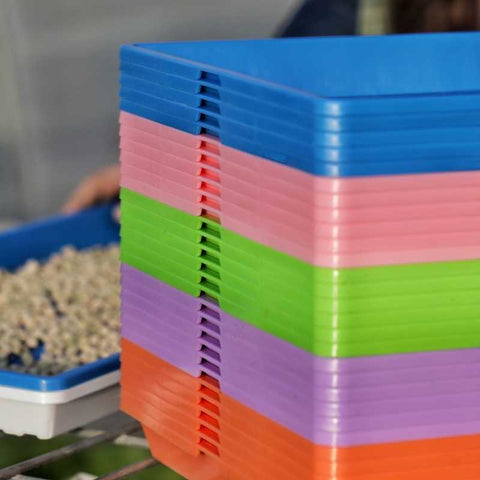
Microgreen Grow Light Options
Sunlight and Natural Light for Growing Microgreens
This is, of course, the cheapest and most complete spectrum light source available. For the home grower, any sunny window sill or small greenhouse can be used to grow microgreens, although with windows, you will have more issues with curved stems and slower, leggier growth. Windows can provide enough light to get you by but are really only an option for those growing at home for personal use.
Related: Learn How to Grow Microgreens 101
In larger-scale operations, greenhouses or high tunnels with tables can be used to grow microgreens when limited space is not a concern. In a greenhouse or high tunnel, you don't need additional artificial lighting to grow microgreens well.
Pros: Free, readily available, no wiring or timers needed, complete light spectrum in the 6500k range on a clear day.
Cons: Inconsistent due to seasons and weather, produces heat that can affect growth, does not work well in vertical rack systems, requires supplemental lighting in winter months, can cause leggy microgreens and slow growth in some scenarios.
Fluorescent Shop Lights
Fluorescent shop lights are similar to LEDs in light production but use more power and produce more radiant heat so we don’t recommend them here. They also regularly contain mercury which can contaminate your grow area if the bulbs are broken. If you are using existing fixtures we recommend replacing the Fluorescent and CFL bulbs with LED.
LED Bulb Shop Lights
LED bulb shop lights can be purchased at most big box stores for around $20 a piece and they are a standard 4’ long. These make an excellent trial light when you are ready to try growing indoors or expand to a vertical rack and increase growing capacity in a limited footprint.
These LED shop lights work fine for microgreens that have shorter growing cycles but struggle when trying to grow microgreens with longer growing cycles like herbs. If you want to grow these kinds of microgreens, you should go for an alternative type of light system. We have a top ten list of our favorite microgreens to grow here that you can use as a jumping-off point.
Pros: Inexpensive, easy to find, acceptable in many light spectrums, produces minimal heat, can usually be daisy-chained 3-4 lights, work with 120v household electrical outlets.
Cons: Bulbs are often unprotected from water and dust making them susceptible to damage, brands vary greatly in quality, are normally designed to be installed horizontally only, are less efficient than strip LEDs, generally last far fewer hours than strip lights, shop lights are not generally designed for plant growth and are offered in many spectrums not ideal for plant growth.
LED Strip Grow Lights (T5)
Strip grow lights like the ones we sell here that are designed for gardening and growing microgreens are available in multiple sizes and intensities. They are often sold in the same standard 4’ as shop lights, but other lengths are available. Full-spectrum strip lights above 5000k run from $75 on the low end through to $650.
Most grow lights offer a standard growing area of 4’x2’. They can come with or without the surrounding reflector that gives it the classic shop light shape, which helps redirect light and therefore increases efficiency. This maximizes the light available and can help increase microgreen yields.
These lights are commonly used in vertical growing systems because they can be installed vertically or horizontally.
Pros: Moderately expensive, can be found in hydroponic stores and online, full light spectrum 4500k and above allows for longer growing periods, produces minimal heat, efficient watt to lumen ratio, the good ones offer lighting surfaces that are protected from dust and water, can usually be daisy-chained up to 7 lights, most work with 120v household electrical outlets, some can be installed vertically if needed for your set up.
Cons: Moderately expensive(pro or con depending on your situation); quality, efficiency, and longevity can vary greatly between brands.
LED Panel Lights for Growing Microgreens
These are the top-of-line growing lights for indoor use and can be used for microgreens as well as all other types of plants. They are generally used in the large-scale commercial growing of plants that need to reach full size or reach the flowering stage indoors.
The high light intensity found in these lights could be considered overkill for growing microgreens. Ranging in price from $99 up to thousands of dollars, they can be very expensive for a small grower. The growing area that these lights cover is typically 3’x3’ for smaller panels up through 8’x8’.
Pros: Come in a variety of sizes, intense full-spectrum light capabilities, variable sizes for customized growing spaces, highly efficient watt to lumen ratio.
Cons: Expensive, thick profile limits their ability to work in vertical rack systems, generally require separate ballasts for electricity, must be purchased from specialty suppliers online or in hydroponics stores if they are available in your area.

How far should my lights be from microgreens?
The distance that your lights need to be from your microgreens is generally between 6-12 inches above your microgreens. However, the type of light source that you use can affect the ideal distance because certain lights produce heat that can burn the microgreens if placed too close.
Most LED strip lights do not generate enough heat to cause problems and do well 6-12 inches from the surface of the growing greens. The farther the greens are from the light source the more they will “stretch” and become leggy.
Panel lights are higher intensity and can be placed farther from the growing surface without too much light loss.

How Many Hours of Light Do Microgreens Need?
In general, plants (including microgreens) need at least six hours a day of quality light in order to grow.
If you are using sunlight as your main light source, you are not really able to control the light exposure and intensity. But by being aware of shade patterns and light direction when setting up your system, you can maximize the light available to you.
When growing indoors, it's important to experiment with the light sources available to you so that you can grow your microgreens effectively and easily in a way that works for you. Some growers keep lights on 24/7, others use 12 hours on/12 hours off modified daylight system to grow their microgreens.
You can also do 18 hours on/6 hours off system that provides a balance between pushing for growth and allowing for "rest" time for the plants. Some growers say that this system provides the best color and flavor to develop in the microgreens, so it's important to test the different light exposure times until you find something you're happy with.
What do light spectrums have to do with growing microgreens?
Microgreens normally don't need as high of a light spectrum available to them in order to grow effectively. Light spectrum comes more into play when you're dealing with other types of plants that have longer growing cycles (tomatoes and peppers) or plants that you're trying to push to the flowering stage (chamomile, zinnias, cross-breeding experiments).
However, some types of microgreens do need a higher light spectrum because they take longer to grow. When growing herbs or other plants for micros that have a growing cycle longer than 20 days, you need to upgrade your lights so that they produce a color temperature above 4500k.
Most lights will be labeled between 2000K to 6500k. On the lower end of this scale (color temperatures from 2000K to 3000K) are referred to as “warm white” and range from orange to yellow-white in appearance.
Color temperatures between 3100K and 4500K are referred to as “cool white.” This range will emit a neutral white light.
Above 4500K will give off a blue-white light that mimics daylight and is what you need for any plant with a growing cycle longer than 20 days, including microgreen herbs.
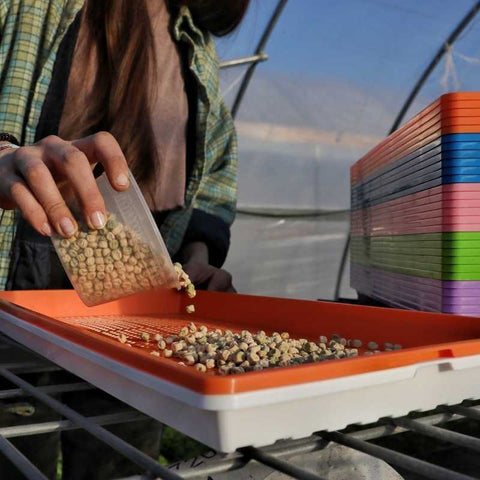
What are the best lights for microgreens?
When it comes to lights for growing microgreens, there are a few things to consider. The most important factors are the wattage, lumens, and spectrum of the light. Other specs, such as coverage area and PAR levels, can also be important depending on your setup. There are many factors that go into play to determine which lights are right for you.
LED grow lights are a popular option because they are affordable, energy-efficient, and produce consistent results. They come in a variety of spectrums so you can find one that matches your needs. Additionally, they are energy efficient so they are environmentally friendly and save you money on your electric bill.
How many watts do microgreens need?
Watts are not a good measurement of light for grow lights since watts are a measurement of how much energy is used, not how much light is produced. LED lights use far fewer watts than other types of bulbs.
Microgreens thrive with supplemental light, but they don't need as much as other plants. This is because most varieties of microgreens are grown in short cycles of less than 20 days. We provide grow lights that are flexible and can be used for microgreens or any other plants you want to grow.
Microgreens are typically grown in a dark environment for the first few days of their lives. After that, they need to be transferred to an area where they can get at least six hours of sunlight daily.
What's a T8 fluorescent?
A T8 fluorescent light is a type of tubular light that is 8/8 of an inch in diameter (aka one inch) compared to a T5 light, which is 5/8" in diameter. A T8 is larger than a T5 in diameter and longer. The lumens and watts of a T8 are typically lower than a T5 light, so while it is more energy-efficient, you end up unable to reach high enough lumens for most plants to grow.
A T8 fluorescent light would be sufficient for microgreens if you intend to grow them only with a growing cycle shorter than 20 days. If you grow a longer-cycle microgreen or want to use these lights for other plants as well, a T8 will not be the right light for you.

When should I expose microgreens to light?
Microgreens should grow in darkness (often stacked, as described in this article) for about 3-5 days after sprouting to ensure higher yields and easier harvesting. Slower-growing microgreens will be on the longer end of this spectrum while faster-growing microgreens will be on the shorter end.
How do you know your microgreens are getting enough light?
If your microgreens aren't getting enough light, they will stretch out and be weak and thin. Leggy microgreens are a result of not having enough light. When they lack light, the plants stretch out in search of it. This makes them less aesthetically pleasing and affects the greens' flavor.
Too much light or light placed too close to the plants can also be harmful to microgreens. It can cause them to lose their color and stockiness and burn the tops.
How many hours a day should your microgreens get light?
Microgreens need at least 6 hours of light but do best when put on a schedule of 18 hours on and 6 hours off. Some growers prefer an even 12-on and 12-off model, but we like extending the light period to encourage faster growth.
What is the best color temperature for microgreens?
The best color temperature for microgreens is around 4,000 K to 6,500 K. This range provides the plants with enough blue and red light for photosynthesis, which results in fast growth. Daylight colors have a color temperature between 4,600K and 6,500K, so using fluorescent light bulbs in this range will be ideal.
Microgreens can be grown at a cooler light temperature but will have the best color and grow fastest in this optimal range.
What light intensity do you need for microgreens?
Microgreens need at minimum 20 watts per tray and ideally lumens that fall in the daylight spectrum - 4600K-6500K.
The amount of light you need for microgreens depends on the intensity of the light and how close it is to the plants. In our automated grow rack system, we have 4 T5 LED lights at 6500K per shelf.
Can a grow light be too strong?
Grow lights can be too strong if placed too close to the plants or designed for commercial operations and used at home. Some lights are so strong that they can bleach the colors of everything around them, so they are not a good choice for a home grower.
The stronger the grow light, the further away from the top of the plants the lights should be. We recommend using a T5 as a standard light source for all plants, including microgreens.

Also in Microgreens Guides & Resources
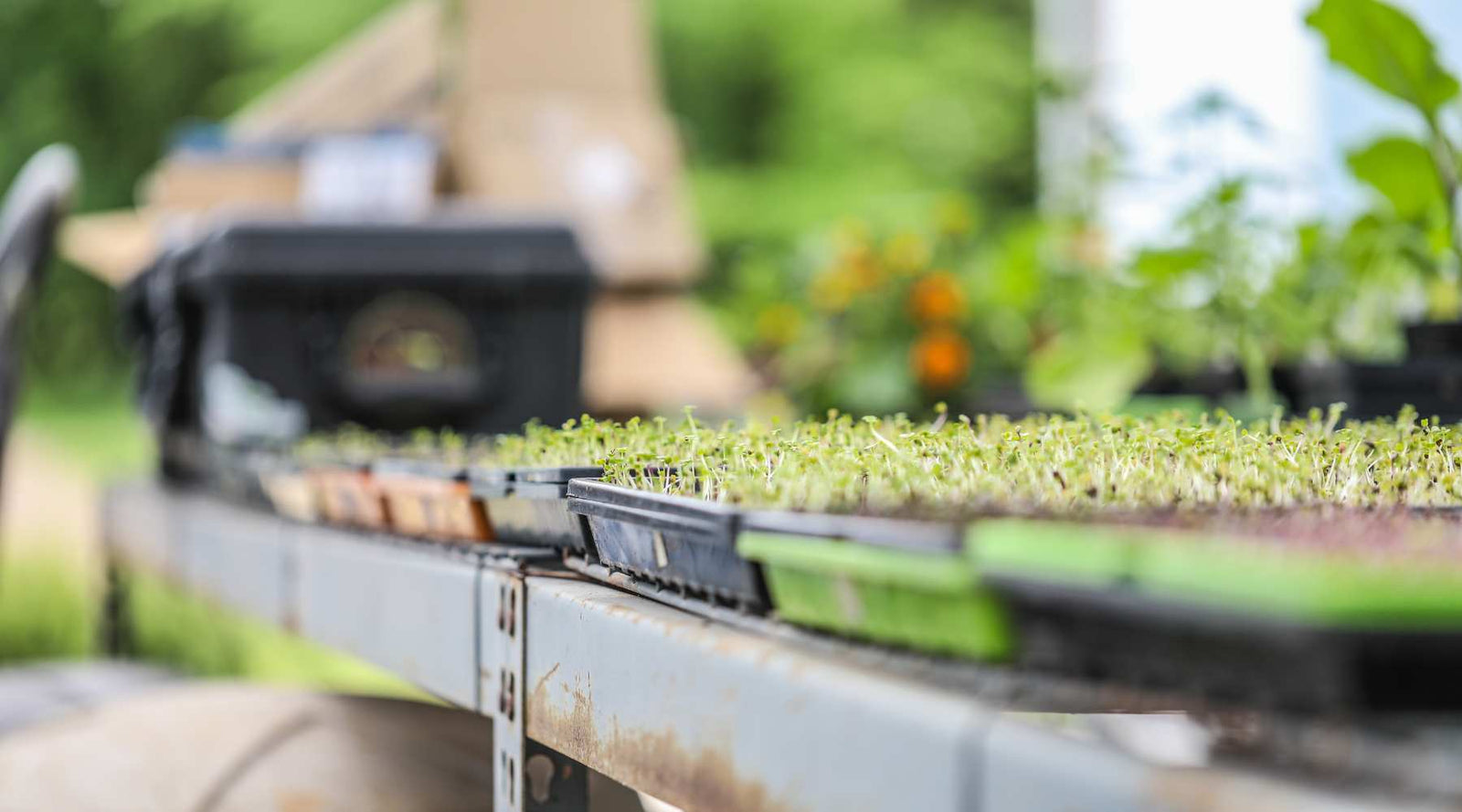
How to Market Microgreens: Strategies That Get Results
March 27, 2025 13 min read 0 Comments
In this article, we’ll help you stay at the top of your microgreen game to help you succeed in this exciting venture.

Must-Know Tips for Edible Flower Farming Success
October 20, 2025 9 min read 0 Comments
Learn how to expand your markets, what popular edible flowers to offer, marketing tips, new trends, and best practices.
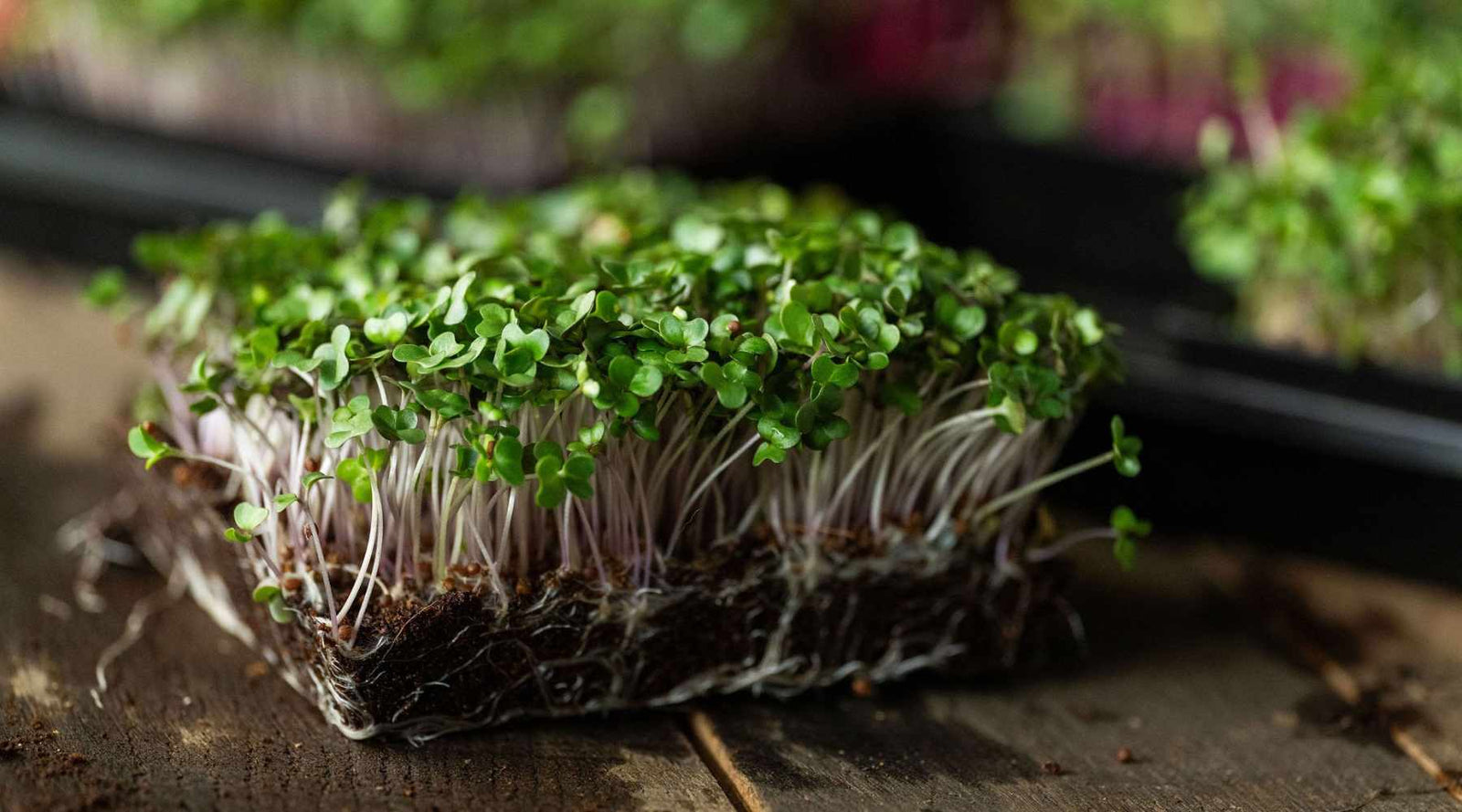
How To Grow Microgreens Indoors - SEED to HARVEST
June 12, 2025 7 min read 0 Comments
Recent Articles
- How to Market Microgreens: Strategies That Get Results
- Must-Know Tips for Edible Flower Farming Success
- What Lights Do I Need to Grow Microgreens?
- How To Grow Microgreens Indoors - SEED to HARVEST
- A Quick Guide to Starting a Microgreens Business
- How and When to Use 10x10 Microgreen Trays to Grow Nutrient-Packed Greens
- How to Disinfect Seeds Before Planting and Sprouting
- Top 5 Best Growing Mediums for Microgreens
- What Trays Do You Need for Microgreens and Propagation?
- Top Ten Microgreens to Grow
Subscribe
Sign up to get the latest on sales, new releases and more …
